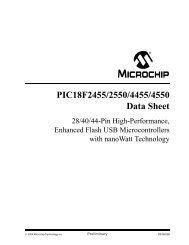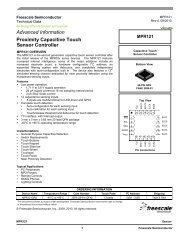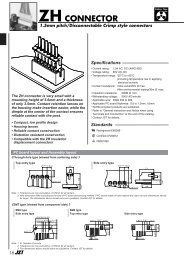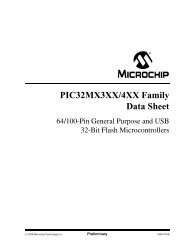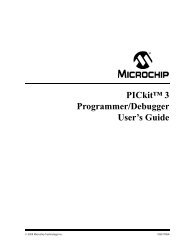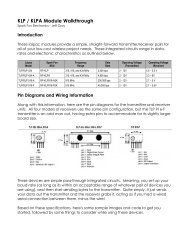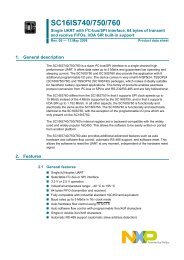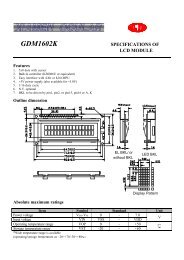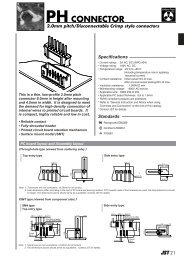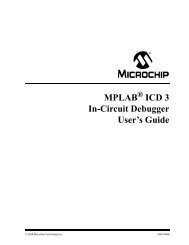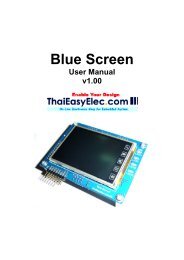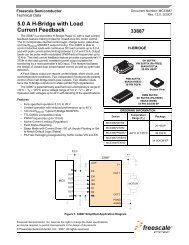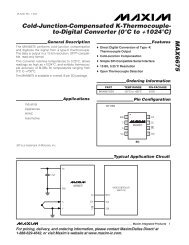PIC24HJ64 Datasheet
PIC24HJ64 Datasheet
PIC24HJ64 Datasheet
You also want an ePaper? Increase the reach of your titles
YUMPU automatically turns print PDFs into web optimized ePapers that Google loves.
PIC24HJ32GP302/304, <strong>PIC24HJ64</strong>GPX02/X04, AND PIC24HJ128GPX02/X04<br />
24.5 JTAG Interface<br />
PIC24HJ32GP302/304, <strong>PIC24HJ64</strong>GPX02/X04, and<br />
PIC24HJ128GPX02/X04 devices implement a JTAG<br />
interface, which supports boundary scan device<br />
testing, as well as in-circuit programming. Detailed<br />
information on this interface is provided in future<br />
revisions of the document.<br />
Note:<br />
Refer to Section 24. “Programming and<br />
Diagnostics” (DS70246) of the PIC24H<br />
Family Reference Manual for further<br />
information on usage, configuration and<br />
operation of the JTAG interface.<br />
24.6 In-Circuit Serial Programming<br />
The PIC24HJ32GP302/304, <strong>PIC24HJ64</strong>GPX02/X04,<br />
and PIC24HJ128GPX02/X04 devices can be serially<br />
programmed while in the end application circuit. This is<br />
done with two lines for clock and data and three other<br />
lines for power, ground and the programming<br />
sequence. Serial programming allows customers to<br />
manufacture boards with unprogrammed devices and<br />
then program the microcontroller just before shipping<br />
the product. Serial programming also allows the most<br />
recent firmware or a custom firmware to be<br />
programmed. Refer to the “dsPIC33F/PIC24H Flash<br />
Programming Specification” (DS70152) for details<br />
about In-Circuit Serial Programming (ICSP).<br />
Any of the three pairs of programming clock/data pins<br />
can be used:<br />
• PGC1/EMUC1 and PGD1/EMUD1<br />
• PGC2/EMUC2 and PGD2/EMUD2<br />
• PGC3/EMUC3 and PGD3/EMUD3<br />
24.8 Code Protection and<br />
CodeGuard Security<br />
The <strong>PIC24HJ64</strong>GPX02/X04 and PIC24HJ128GPX02/<br />
X04 devices offer advanced implementation of<br />
CodeGuard Security that supports BS, SS and GS<br />
while, the PIC24HJ32GP302/304 devices offer the<br />
intermediate level of CodeGuard Security that supports<br />
only BS and GS. CodeGuard Security enables multiple<br />
parties to securely share resources (memory,<br />
interrupts and peripherals) on a single chip. This<br />
feature helps protect individual Intellectual Property in<br />
collaborative system designs.<br />
When coupled with software encryption libraries,<br />
CodeGuard Security can be used to securely update<br />
Flash even when multiple IPs reside on the single chip.<br />
The code protection features vary depending on the<br />
actual PIC24H implemented. The following sections<br />
provide an overview of these features.<br />
Secure segment and RAM protection is implemented<br />
on the <strong>PIC24HJ64</strong>GPX02/X04 and<br />
PIC24HJ128GPX02/X04 devices. The<br />
PIC24HJ32GP302/304 devices do not support secure<br />
segment and RAM protection.<br />
Note:<br />
Refer to Section 23. “CodeGuard<br />
Security” (DS70239) of the PIC24H<br />
Family Reference Manual for further<br />
information on usage, configuration and<br />
operation of CodeGuard Security.<br />
24.7 In-Circuit Debugger<br />
When MPLAB ® ICD 2 is selected as a debugger, the incircuit<br />
debugging functionality is enabled. This function<br />
allows simple debugging functions when used with<br />
MPLAB IDE. Debugging functionality is controlled<br />
through the EMUCx (Emulation/Debug Clock) and<br />
EMUDx (Emulation/Debug Data) pin functions.<br />
Any of the three pairs of debugging clock/data pins can<br />
be used:<br />
• PGC1/EMUC1 and PGD1/EMUD1<br />
• PGC2/EMUC2 and PGD2/EMUD2<br />
• PGC3/EMUC3 and PGD3/EMUD3<br />
To use the in-circuit debugger function of the device,<br />
the design must implement ICSP connections to<br />
MCLR, VDD, VSS, PGC, PGD and the EMUDx/EMUCx<br />
pin pair. In addition, when the feature is enabled, some<br />
of the resources are not available for general use.<br />
These resources include the first 80 bytes of data RAM<br />
and two I/O pins.<br />
© 2008 Microchip Technology Inc. Preliminary DS70293B-page 259



